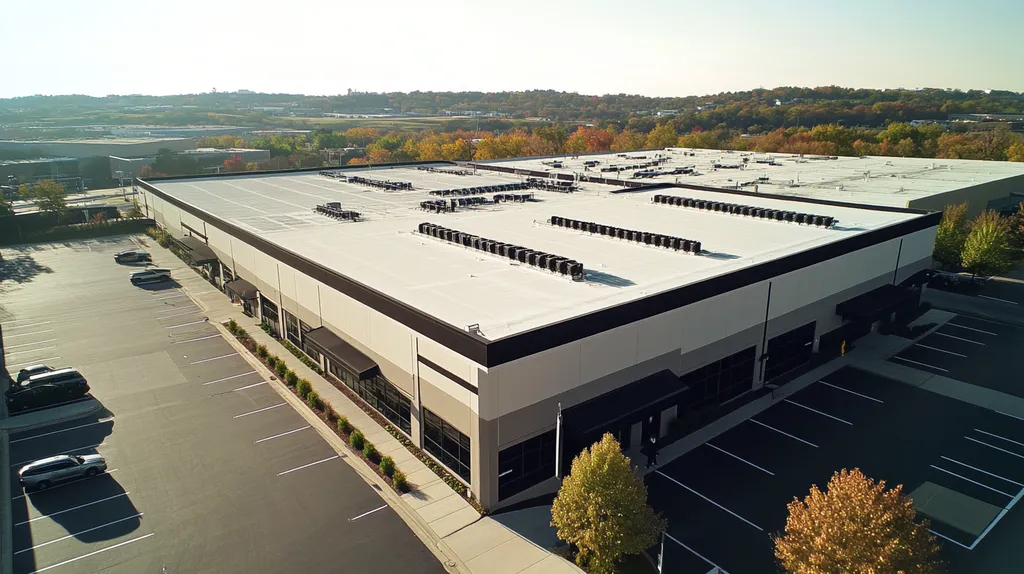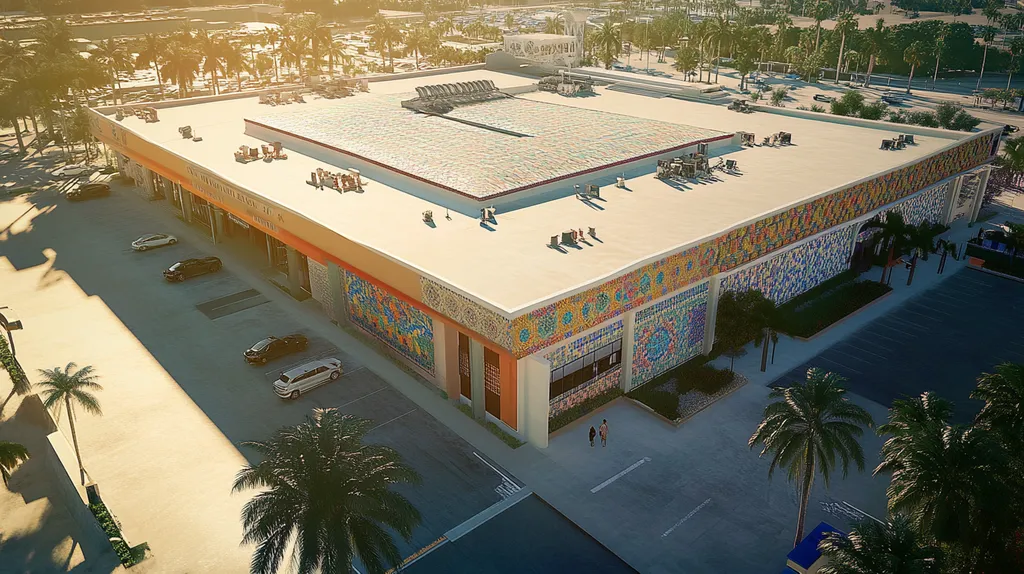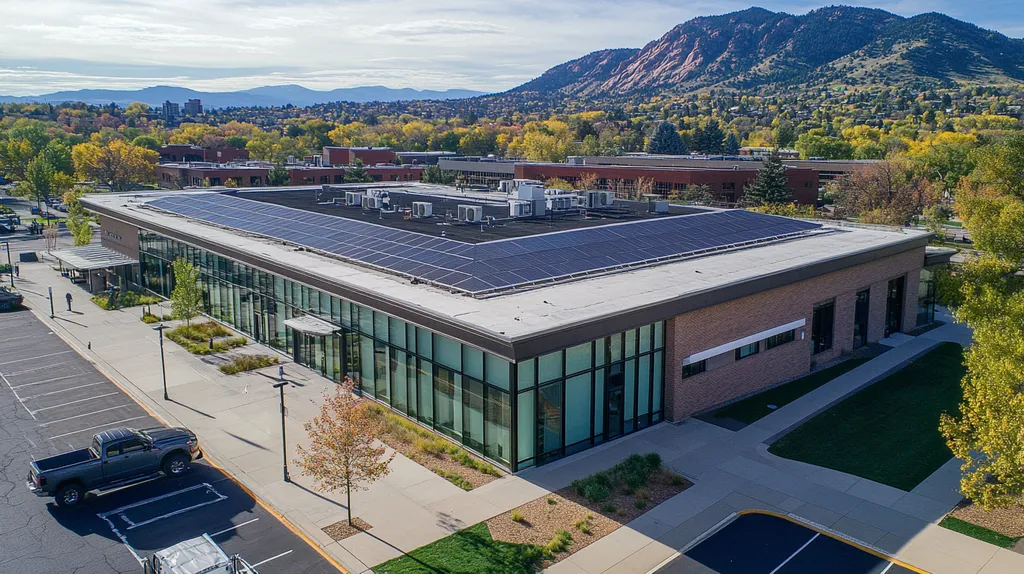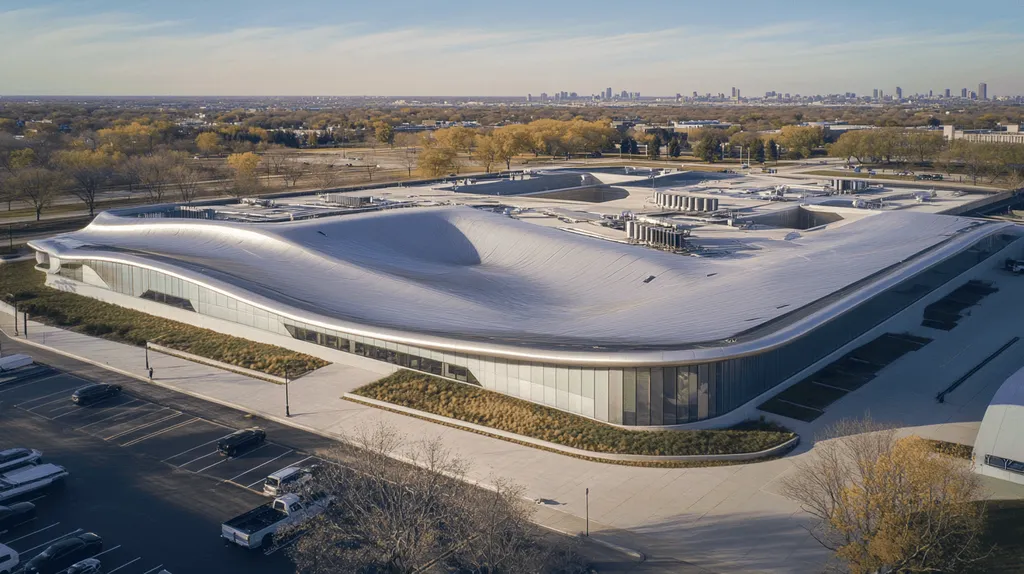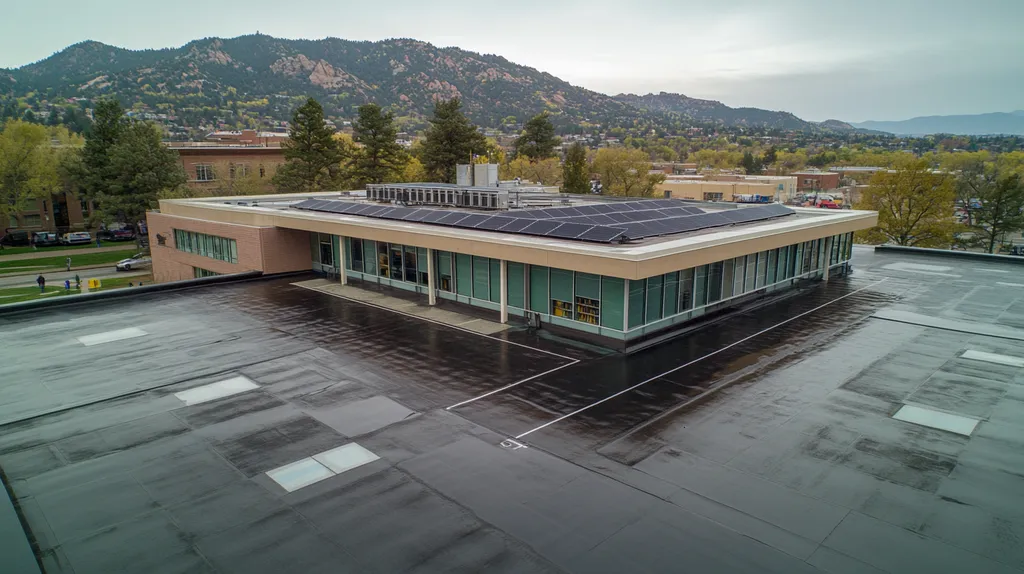In commercial roofing, warranty oversight failures cost property owners an estimated $2.7 billion annually in preventable repairs and premature replacements. Despite these staggering losses, studies show that 73% of building managers lack a comprehensive understanding of their roof warranty terms.
For facility managers and property owners, mastering warranty review isn’t just about documentation – it’s about protecting a critical business asset and avoiding costly oversights that can void coverage.
This comprehensive guide breaks down the essential components of commercial roof warranties, from fundamental concepts to optimization strategies, providing actionable insights for maximizing warranty protection and return on investment.
SECTION 1: FUNDAMENTAL CONCEPTS
Grasping the ins and outs of commercial roof warranties isn’t just helpful; it’s crucial for building owners and facility managers alike. A lackluster warranty can lead to steep repair bills and even legal headaches. In fact, inadequate warranty management can drain as much as 20% of a company’s budget for roof replacement. This section will clarify what commercial roof warranties are, delve into their various types, and underscore their importance for all stakeholders involved.
Definition of Commercial Roof Warranties
Commercial roof warranties serve as a safety net, protecting property owners from defects and failures in roofing materials and installation. These agreements are formed between property owners and roofing manufacturers or contractors. They precisely outline the coverage duration, types of damages included, and the responsibilities of everyone involved.
The primary goal of these warranties is to provide reliability and support throughout the life of the roof. Coverage can vary widely, encapsulating everything from material defects to installation errors. For property owners, understanding the fine print is vital to avoiding unforeseen financial burdens.
Warranties act as a reassurance, guaranteeing that property owners won’t face daunting repair costs from unexpected issues. Familiarity with what is covered helps them tackle problems proactively, contributing to the overall longevity of the roof.
It’s essential to recognize the difference between “full” and “limited” coverage. Full warranties generally offer complete repairs and replacements, while limited warranties may come with restrictions that affect how claims are processed and what types of damages are eligible for coverage.
Types of Commercial Roof Warranties
Commercial roof warranties come in various types, each crafted to meet specific needs. The two main categories are material warranties and workmanship warranties. Material warranties specifically address damage caused by defects in the roofing materials, ensuring protection for materials used.
On the flip side, workmanship warranties focus on errors during the installation process. Some warranties offer a combination of both, providing comprehensive coverage for roofing issues. Understanding these distinctions is crucial for property owners making informed choices.
Another factor to consider is the duration of the warranty. Short-term warranties might last a mere few years, whereas longer warranties can extend for 30 years or more. This duration affects financial planning and risk assessment for property owners.
Additionally, certain warranties may include specific guarantees from manufacturers or contractors. These guarantees further bolster security, outlining the responsibilities of contractors to maintain quality standards, thereby reducing potential risks for the property owner.
Importance of Warranties for Building Owners
Warranties play a vital role in minimizing financial risks associated with roofing systems. They shield building owners from potentially hefty repair costs arising from material defects or installation failures. A well-structured warranty can save owners thousands by addressing unforeseen damages efficiently.
Moreover, a thoroughly reviewed warranty can boost a building’s resale value. Prospective buyers often seek comprehensive warranties as indicators of a property that has been well cared for. This can facilitate quicker sales and potentially higher offers.
Clearly defined warranties also streamline the process of resolving disputes between property owners and contractors. As roofs age, issues can arise, and having explicit warranty terms fosters better communication and accountability.
Ultimately, taking the time to understand warranty terms can yield substantial long-term benefits, keeping building owners protected against unpredictable risks. Knowing what is included can greatly improve overall facility management strategies and enhance peace of mind.
SECTION 2: SYSTEM COMPONENTS
Understanding the components of a commercial roof warranty is essential for property owners and facility managers. Overlooking these details can lead to unexpected repair costs and unmet expectations. A comprehensive warranty should encompass several key elements: manufacturer warranties, contractor workmanship, and materials. Each plays a vital role in contributing to the overall durability and reliability of a roofing system.
Manufacturer’s Warranty Coverage
Manufacturer warranties form the backbone of any roofing system. They generally cover the materials used and outline performance expectations under normal conditions. For example, a typical warranty might ensure that a roof will remain leak-free for a specific period, often spanning 10 to 30 years.
However, these warranties often include exclusions and conditions that may be overlooked. Issues such as improper installation or failure to maintain the roof can void the warranty, potentially leaving property owners exposed. Understanding these limitations is crucial for maintaining compliance and protecting the roof’s integrity.
Manufacturers frequently offer different tiers of coverage, ranging from basic to premium plans. Investing in a more comprehensive warranty can offer peace of mind, especially when using high-end roofing materials. Property owners should always scrutinize the fine print to fully comprehend what is covered and what is not.
The claims process can also be complex. Property owners might need to provide evidence, such as maintenance logs and installation records, to access warranty benefits. Familiarity with these requirements can significantly influence how claims are handled, ensuring a smoother resolution.
Contractor’s Warranty and Workmanship
Contractor warranties are focused on the quality of workmanship and the installation process. These warranties are critical because they hold the contractor responsible for any mistakes made during installation. Typically, they range from 1 to 10 years, depending on the contractor and the complexity of the job.
A robust contractor warranty can help prevent costly repairs due to installation errors. For instance, if a roofing system is improperly sealed and leads to leaks, the contractor would be obligated to fix these issues at no extra cost to the property owner if covered under the warranty.
Property owners should assess their contractor’s track record and warranty offerings carefully. Not all contractors provide the same level of coverage, so evaluating their reputation is often as important as the warranty terms themselves.
Additionally, ensuring that the contractor is certified by the manufacturer is vital. Many manufacturers offer enhanced warranty coverage when their products are installed by certified contractors, providing an added layer of protection.
Labor and Materials Warranties
Labor and materials warranties ensure that both the workmanship and the materials used meet industry standards. These warranties cover labor costs associated with repairing or replacing defective materials, making them essential for property owners.
For instance, a materials warranty might address defects in roofing shingles, while a labor warranty ensures that any installation issues related to those shingles are resolved. Understanding these warranties can streamline the resolution process in the event of roof failures.
When evaluating these warranties, it’s important to look for comprehensive terms. Some warranties may only cover specific types of failures, leaving property owners vulnerable. Carefully assessing the duration and conditions of these warranties enables informed decision-making.
Lastly, property owners must prioritize regular maintenance. Many warranties stipulate that routine inspections and maintenance documentation are necessary for validity. Careful record-keeping can safeguard investments in the roof and maintain warranty rights, ensuring peace of mind long-term.
SECTION 3: IMPLEMENTATION METHODS
Understanding warranty terms is essential for protecting investments and avoiding unexpected financial burdens. Each year, property owners experience unnecessary expenses due to misinterpreted warranty terms, leading to costly repairs and maintenance. Gaining clarity on warranty specifics is crucial for effective roof management. This section outlines how to evaluate warranty terms, assess coverage needs, and select the most suitable warranty to meet specific building requirements.
Evaluating Warranty Terms and Conditions
Diving into warranty terms requires a careful eye to sidestep unforeseen pitfalls. Warranty documents can often be lengthy and stuffed with technical jargon, complicating comprehension. Property owners should zero in on critical elements such as the warranty period, coverage specifics, and any limitations that may apply to avoid potential gaps in protection.
For instance, some warranties might cover only defects in materials, leaving installations vulnerable to damages caused by severe weather or inadequate maintenance. By identifying these exclusions, property owners can better predict risks and associated costs. A solid grasp of what is included is vital, as coverage gaps can lead to substantial expenses down the line.
Moreover, understanding the procedures for activating warranty claims is equally important. Some warranties require regular inspections or meticulously maintained maintenance logs. Failure to adhere to these requirements can result in voiding the warranty, leaving property owners unprotected.
Lastly, engaging in open dialogue with roofing contractors about warranty-related queries is key. Contractors can offer valuable insights and clarifications about warranty terms, ensuring that owners have a comprehensive understanding of their warranty’s scope and restrictions.
Assessing Coverage Needs and Options
Choosing the ideal coverage option can significantly affect both long-term costs and a building’s overall integrity. Property owners should start by assessing their unique roofing needs based on the building type, geographic location, and environmental conditions. Each of these factors can influence the roof’s longevity and performance.
For example, facilities in regions that frequently experience severe weather should consider extended warranties that cover a wider array of issues. Similarly, roofs in high-traffic areas may require warranties that address the wear and tear associated with constant foot traffic. Without thorough evaluation, property managers risk opting for coverage that falls short of their actual needs.
It is also worthwhile to compare warranty offerings from various manufacturers. Not all warranties provide the same level of coverage; examining the extent of protection and the duration of coverage can reveal significant disparities. Owners should align these factors with their budget and long-term property goals.
Additionally, consulting with roofing professionals can provide insightful guidance. They can help clarify coverage options within the context of specific building requirements, ensuring that the selected warranty meets the operational needs effectively.
Choosing the Right Warranty for Your Building
Selecting the right warranty is a strategic move that can protect a property’s value. Property owners must recognize that one size does not fit all; thus, tailoring the warranty to the specific building is essential. Factors such as the building’s age, structural design, and overall condition are critical in this decision-making process.
Warranties come in various formats, ranging from full-system coverage to limited-material warranties. Full-system warranties typically cover the entire roofing system—labor and materials—providing comprehensive protection against potential issues. In contrast, limited warranties may only apply to specific components, potentially leaving gaps in coverage.
Furthermore, owners should reflect on their ownership timeline. A long-term ownership outlook often warrants a more robust warranty, ensuring ongoing security against future problems. Conversely, short-term owners might prefer more basic coverage that is less comprehensive but still cost-effective.
Ultimately, collaborating with reputable roofing contractors is essential. Their expertise can direct property owners toward warranties that offer the best balance of protection, cost, and suitability for the unique needs of each building.
SECTION 4: MAINTENANCE REQUIREMENTS
Neglecting the maintenance of a commercial roof can lead to disastrous consequences, including costly repairs and reduced roof lifespan. Research indicates that regular inspections and upkeep can extend a roof’s longevity by 25-50% compared to less-maintained systems. Understanding the maintenance obligations specified in a warranty is essential for property owners and facility managers to protect their investment and prevent significant financial setbacks.
Regular Inspections and Maintenance
Conducting regular inspections is essential for preserving the integrity of a commercial roof. Experts recommend scheduling these inspections at least twice a year and after any severe weather events. Early detection of issues like cracking or blistering can prevent them from escalating into major problems.
Moreover, routine maintenance tasks, such as cleaning gutters and removing debris, greatly enhance the roof’s performance. If neglected, even small issues can develop into leaks that cause interior damage and disrupt operations within the space.
A proactive approach to maintenance can also improve energy efficiency. Keeping the roof clean allows it to reflect sunlight more effectively, which can lower cooling costs during hot months. Investing in regular upkeep not only protects the roof but can also translate into long-term savings on energy bills.
Documentation of maintenance activities is a crucial aspect of warranty compliance. Keeping detailed records of inspections and repairs serves as proof of diligence when filing warranty claims. This documentation can be invaluable when addressing any future issues that may arise.
Compliance with Manufacturer Guidelines
Every commercial roof warranty includes specific guidelines set by the manufacturer, which must be followed to maintain coverage. These guidelines often dictate the frequency of inspections and the procedures for repairs. Ignoring these requirements can jeopardize the warranty.
For example, some manufacturers stipulate that only certified contractors should perform repairs on their roofing systems. Choosing unqualified personnel not only risks voiding the warranty but can also lead to inferior workmanship that compounds existing issues. Adhering to compliance is critical.
Being aware of these requirements enables facility managers to plan effectively for maintenance. Failing to follow the guidelines can lead to costly mistakes that ultimately leave property owners financially exposed.
Additionally, manufacturers typically provide resources to assist property managers in adhering to these guidelines. Engaging with these resources can enhance compliance and improve understanding of best practices, which ultimately helps preserve the roof’s integrity.
Avoiding Warranty Voidance Through Proper Care
Proper care is essential for maintaining a commercial roof warranty. Even minor oversights, like neglecting to clear debris from drains, can lead to damage that voids warranty coverage. This reality underscores the importance of proactive maintenance.
Furthermore, regular inspections should include checks for mold and deterioration. Many warranties specifically condition coverage on keeping the roofing system clean and functional, and ignoring these factors can lead to voidance.
Property owners should also educate their facility staff about the maintenance responsibilities outlined in the warranty. An informed staff is key to identifying and reporting issues promptly, helping to maintain the roof’s integrity and avoid the financial implications of a voided warranty.
Lastly, swift communication with roofing professionals when issues arise is vital. Timely action can prevent minor problems from snowballing into major repairs, ensuring that the roof remains effective and well-protected throughout its lifespan.
SECTION 5: PERFORMANCE METRICS
For property owners and facility managers, grasping the nuances of performance metrics is critical for unlocking the full value of a commercial roof warranty. Ignoring these metrics can lead to skyrocketing repair bills and missed opportunities for financial savings. A recent study revealed that without a proactive monitoring strategy, properties can incur up to 30% higher repair costs over ten years. This section will delve into the key strategies for tracking warranty claims, monitoring roof conditions, and properly measuring cost savings to ensure optimal roof performance.
Tracking Warranty Claims and Resolutions
Effectively tracking warranty claims is essential for ensuring both compliance and effective problem resolution. Each claim should be meticulously documented, capturing critical details like the date of the issue, its nature, and how long it took to resolve. This diligent record-keeping enables property owners to spot emerging patterns that could signal systemic issues with the roofing system or its installation.
Additionally, analyzing resolved claims reveals insights into the responsiveness of the warranty. If claims consistently take longer than anticipated to resolve, this may point to deficiencies in the contractor’s support framework, prompting a review of service providers. Regular audits of claims can yield valuable data that informs future roofing decisions, making it easier to engage with contractors during discussions about renewals.
By adopting a proactive tracking approach, property owners can enhance their decision-making processes and reduce the risks associated with warranty claims. Those who prioritize this metric are better positioned to safeguard their investments in roofing materials and services.
Monitoring Roof Condition Over Time
Proactively monitoring the condition of the roof is key to enjoying the full benefits of warranty coverage. Scheduled inspections and routine maintenance checks allow property owners to effectively assess any wear and tear, helping to nip potential problems in the bud before they escalate into complications that could void warranty protection.
Incorporating technology, such as drones and infrared scans, enhances monitoring efforts significantly. These tools provide detailed insights into roof conditions without requiring extensive physical access. Early detection of potential issues allows property managers to carry out timely repairs, preserving both the integrity of the roof and the validity of the warranty.
Moreover, keeping a thorough record of the roof’s condition over time serves as an invaluable asset if warranty disputes arise. In these situations, having comprehensive documentation of maintenance and inspections can bolster the claims process immensely. By consistently assessing roof conditions, property managers not only comply with warranty stipulations but also extend the roof’s lifespan and performance.
Measuring Cost Savings and ROI
Assessing the return on investment (ROI) from a commercial roof warranty is vital for effective financial planning. By calculating savings derived from warranty services, facility managers can make more informed maintenance and repair decisions. For example, tracking the costs saved through warranty claims against the initial warranty expense clarifies the overall financial benefits.
Furthermore, quantifying reduced downtime due to unexpected roof-related issues significantly enhances perceived ROI. In sectors with critical operations, minimizing interruptions can conserve not only revenue but also protect the organization’s reputation.
An updated roof can also lead to lower energy expenses, especially as modern warranties often cover energy-efficient systems. It’s crucial for property owners to factor in these additional savings when evaluating warranty performance.
Ultimately, a comprehensive analysis of cost savings and ROI empowers property managers to justify roofing investments while refining their budgets for upcoming projects. By establishing clear criteria for measuring financial performance, stakeholders can make smarter, more effective roofing decisions for the future.
SECTION 5: PERFORMANCE METRICS
For property owners and facility managers, grasping performance metrics is crucial for unlocking the full potential of a commercial roof warranty. Failing to diligently monitor these metrics can result in soaring repair costs and lost revenue opportunities. Research indicates that without a proactive monitoring strategy, properties can incur up to 30% higher repair costs over a ten-year period. This section will guide you through effectively tracking warranty claims, monitoring roof conditions, and measuring cost savings to ensure your roof performs at its best.
Tracking Warranty Claims and Resolutions
Tracking warranty claims is essential for compliance and effective resolution of issues. Each claim should be meticulously recorded, capturing key details such as the date of the issue, the nature of the problem, and the timeline for resolution. This careful documentation enables property owners to identify patterns that may indicate underlying issues with the roofing system or installation quality.
Moreover, analyzing resolved claims can provide insights into how responsive the warranty service really is. For instance, if claims consistently take longer than expected to resolve, it may signal weaknesses in the contractor’s support structure, prompting a reevaluation of service providers.
Conducting regular audits of claims can yield valuable data that informs future roofing decisions. By maintaining organized records, facility managers can leverage this information during renewal discussions or when selecting new roofing contractors.
Ultimately, effective tracking cultivates better decision-making and mitigates risks related to warranty claims. Property owners who prioritize this metric are in a stronger position to safeguard their investments in roofing materials and services.
Monitoring Roof Condition Over Time
Proactively monitoring the condition of the roof is critical for maximizing warranty benefits. Scheduling regular inspections and maintenance checks is necessary to effectively assess wear and tear over time. This routine vigilance can prevent minor issues from escalating into serious problems that could void warranty coverage.
Incorporating technology, such as drones and infrared scans, enhances monitoring efforts, allowing for detailed insights into roof conditions without requiring extensive physical access. Leveraging these tools can lead to early detection of potential issues, enabling timely repairs that preserve both the roof’s integrity and its warranty.
Documenting the roof’s condition consistently serves as a valuable reference for future warranty claims. Should disputes arise, having comprehensive evidence of maintenance and inspections supports the claims process significantly. Property owners should consider establishing a maintenance log that records inspections, repairs, and observations over time.
By continually evaluating roof conditions, property managers not only meet warranty requirements but also improve the longevity and performance of the roofing system.
Measuring Cost Savings and ROI
Assessing the return on investment (ROI) associated with a commercial roof warranty is vital for effective financial management. By calculating savings derived from warranty services, facility managers can make informed decisions about maintenance and repairs. Tracking costs saved through warranty claims versus initial warranty expenses offers a clearer understanding of financial benefits.
Additionally, quantifying reductions in downtime due to unexpected roofing issues enhances perceived ROI. For businesses with critical operations, minimizing interruptions preserves revenue and protects organizational reputation.
An updated roof can also contribute to lower energy costs, particularly because modern warranties frequently cover energy-efficient systems. Property owners should incorporate these ongoing savings into their evaluations of warranty performance.
Ultimately, conducting a thorough analysis of cost savings and ROI empowers property managers to justify roofing investments while refining budgets for future projects. By establishing clear criteria for measuring financial performance, stakeholders can make more informed, strategic roofing decisions moving forward.
The Bottom Line
With commercial roof warranties representing investments worth billions of dollars annually, proper warranty management has never been more critical for protecting business assets.
Industry data shows that properties with well-managed warranty programs experience 40% fewer catastrophic roof failures and save an average of $2.15 per square foot in lifetime maintenance costs.
Success requires a systematic approach: understanding warranty types, maintaining proper documentation, following manufacturer guidelines, and tracking performance metrics.
For property owners and facility managers, the path forward is clear: implement comprehensive warranty review protocols, maintain rigorous compliance programs, and leverage warranty protections to maximize roof longevity and ROI.
The difference between effective warranty management and oversight can mean hundreds of thousands in unexpected costs or decades of reliable protection.
FREQUENTLY ASKED QUESTIONS
Q. What are commercial roof warranties?
A. Commercial roof warranties protect property owners from defects and failures in roofing materials and installation. These agreements are crucial for managing risks and minimizing unforeseen costs. Familiarizing yourself with warranty details can significantly reduce financial burdens and ensure better roof management.
Q. What are the types of warranties for an industrial roof?
A. The main types of warranties include material warranties, which cover defects in materials, and workmanship warranties that address installation errors. Some warranties combine both for comprehensive coverage. Understanding these types helps property owners make informed decisions about their roofing needs and risks.
Q. How can I evaluate the terms of a commercial roof warranty?
A. Evaluating warranty terms involves carefully reviewing coverage specifics, limitations, and the warranty period. Focus on exclusions that may leave your roofing vulnerable. Engaging with contractors about ambiguous terms can provide clarity, helping you ensure comprehensive protection and align it with your roof management strategy.
Q. What maintenance is required for a commercial roof warranty?
A. Regular inspections and maintenance are crucial for preserving warranty validity. Property owners should schedule inspections biannually and after severe weather. Documenting these activities helps maintain compliance, ensuring that the warranty remains intact and protecting against potential costly repairs.
Q. How do I track warranty claims for my commercial roof?
A. Tracking warranty claims involves documenting each claim’s details, including dates and resolutions. Regular audits of the claims process can reveal trends and efficiency. This organized approach helps in addressing emerging issues and negotiating better terms in future contracts with service providers.
Q. What performance metrics should I monitor for my commercial roof?
A. Important performance metrics include tracking warranty claims, monitoring roof conditions, and measuring cost savings from warranty services. Regular assessments encourage timely repairs, preserving the integrity of the roof. Evaluating these metrics can yield actionable insights, helping to justify roofing investments and improve decisions.
Q. Can I transfer a commercial roof warranty when selling my property?
A. Yes, many warranties can be transferred to new property owners, provided they meet specific conditions. This transfer can enhance the property’s resale value, making it more attractive to potential buyers. However, it’s vital to review the warranty terms to understand any necessary procedures or fees involved in the transfer.

